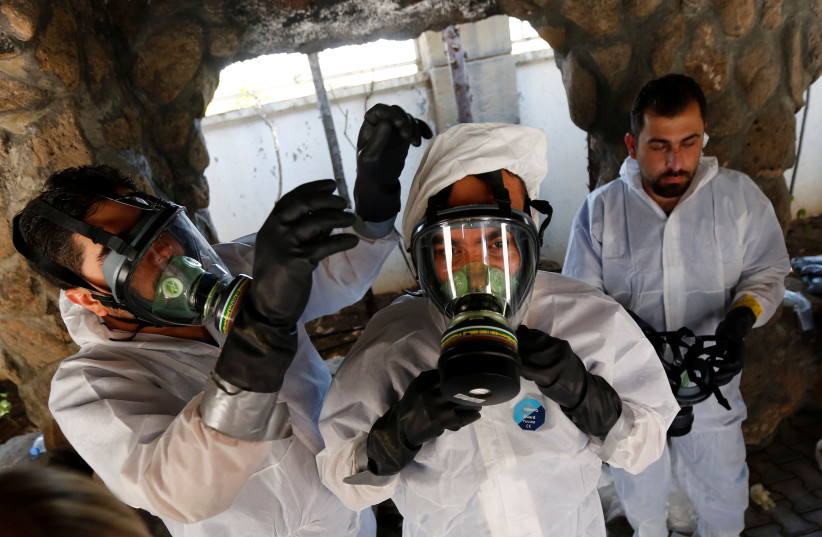Iran is working to take over Syria’s chemical weapons industry – report
Iran is seeking to take over key parts of the Syrian defense industry, a new report by the Alma Research and Education Center, said on Wednesday.
Alma is focused on security threats to northern Israel and regularly reports on Iran, Hezbollah, and other threats in Syria and Lebanon.
“Syria is still producing and storing chemical substances at CERS with the feasibility of future military use, breaching International agreements,” the report said. CERS is also known as the Scientific Studies and Research Center (SSRC).
How is Iran trying to take over parts of the Syrian defense sector?
The investment in chemical weapons by Syria has been a serious threat for decades. Syria was supposed to dismantle its chemical weapons during the Syrian Civil War. However, the SSRC has continued work on various projects. Iran also plays a role in these sites. Alma raises concerns that in any next confrontation with Israel “would this type of weapon be used against IDF and Israeli civilians?”
The research also notes that any work with chemicals can lead to disasters like the explosion at the Beirut port caused by ammonium nitrate.
 Syrian medical staff take part in a training exercise to learn how to treat victims of chemical weapons attacks, in a course organized by the World Health Organisation (WHO) in Gaziantep, Turkey, July 20, 2017 (credit: REUTERS/MURAD SEZER)
Syrian medical staff take part in a training exercise to learn how to treat victims of chemical weapons attacks, in a course organized by the World Health Organisation (WHO) in Gaziantep, Turkey, July 20, 2017 (credit: REUTERS/MURAD SEZER)The SSRC which is known in French as the Centre D’Etudes et de Recherches Scientifiques (CERS), was established in 1971. It has a number of sites in Syria with some 20,000 employees.
“Iran’s major focus is to develop and manufacture precision missiles and rockets, cruise missiles, and unmanned aerial vehicles (UAVs) on Syrian soil, using the CERS Center’s institutes in general,” the Alma report says.
By working in Syria, Iran is able to shortcut the logistics needed to move weapons to Syria and Lebanon via a long distance, such as through Iraq to Albukamal on the Iraq-Syria border. The US has sanctioned hundreds of people linked to CERS. In 2018, US airstrikes targeted CERS and the US said that the strikes had set back the Syrian chemical weapons program for many years. Five years later it appears Iran’s tentacles are growing back and so are these dangerous sites.
The Alma report says that CERS centers have been targeted over the years but that “the attacks disrupted but did not entirely halt work at the CERS site[s].”
Several projects were halted but work continues. “The Iranians cling to their goals, even if it means cutting corners or sacrificing production quality.” The report also says that Hezbollah resorting to chemical weapons “in the next confrontation with Israel cannot be ruled out. It is conceivable that missiles/rockets armed with chemical weapons (such as Sarin nerve gas) are being stockpiled for use by Hezbollah in one of the CERS center’s sites in the Masyaf area and will be transferred to Lebanon if so directed. We estimate with a high probability that in a situation of war, the chemical weapons stockpiles will be attacked wherever they are, in Syria and/or Lebanon.”
The Syrian regime believes that these types of weapons serve as a deterrent that helps the regime survive. The regime is backed by Russia and Iran. Syria’s foreign minister recently met with his Iranian counterpart and Syria has returned to the Arab League and held high-level discussions with Jordan and the Gulf in recent years.
The Syrian regime considers the stockpiles of chemical weapons in its possession and the threat they pose, as a guarantee of its survival.
The Alma research describes 10 sites linked to CERS across Syria. It names one of them as As-Safirah outside of Aleppo. An aerial photo image of the Safirah site published in the Alma research shows a weapons storage facility, a factory, and a missile site. Another photo shows the Masyaf site which is located in the hills southwest of Latakia. This site has a missile production facility and storage for the weapons and projects of CERS.
Some of the sites are also linked to Iran’s attempt to create a corridor to the sea, a route across Iraq and Syria that brings Iran to Lebanon and enables it to arm Hezbollah. The Syrian regime and pro-regime Arabic media have blamed Israel for numerous airstrikes over the years, including near Aleppo and at sites linked to Iran in Syria. Israel has said it opposes Iranian entrenchment in Syria and has worked through the Campaign Between the Wars to prevent Iran’s entrenchment.
The Alma report provides a key insight into the individuals behind the CERS sites in Syria. It also sheds light on the sites themselves and the threat that Iran poses by infiltrating these sites and working with Hezbollah.





Comments are closed.